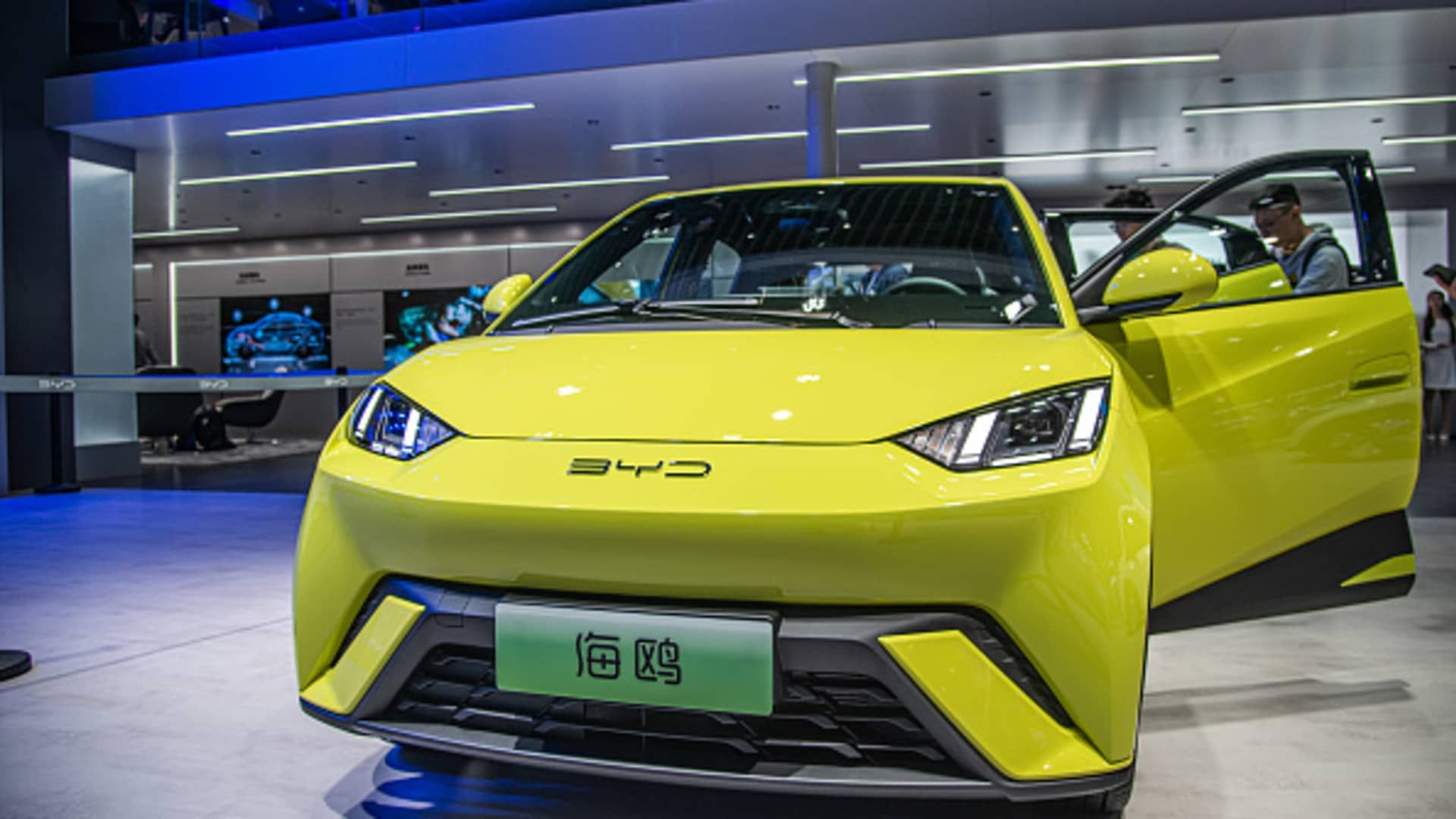A BYD Seagull small electric car is displayed during the 20th Shanghai International Automobile Industry Exhibition at the National Convention and Exhibition Center (Shanghai)
vcg | China Visual Group | fake images
DETROIT – Chinese automakers pose a growing threat to their American counterparts, even without selling directly to consumers in the American market.
Sales of vehicles made in China are increasing at a remarkable rate in Asia, Europe and other countries outside those continents. China recently reported exports of more than 5 million vehicles in 2023, overtaking Japan to become the world's top automobile exporting country.
That volume from well-established state-owned companies like SAIC and Dongfeng, as well as newer players like BYD, Nio and others, has catapulted China from sixth place to first place since 2020. It comes amid declining vehicle exports Americans like companies like General Motors They have cut off international operations. U.S. auto exports in 2022, the most recent data available, are down 25% from their peak in 2016, according to the U.S. Bureau of Economic Analysis.
The United States, fourth in the world in vehicle exports before 2020, ranked sixth in the world last year, behind fifth-ranked Mexico, fourth-ranked South Korea and third-ranked Germany, according to global consulting firm AlixPartners.
“My main competitor is the Chinese automakers,” said Carlos Tavares, chief executive of Chrysler's parent company. stellantis, during a virtual roundtable with the media on Friday. “This is going to be a big fight. There is no other way for a global automaker like Stellantis that operates all over the world than to take on the Chinese automakers head-on. There is no other way.”
The threat extends beyond export volumes. Chinese automakers have set a new standard for vehicle production and pricing. They are launching new models in record times and many are producing electric vehicles efficiently and profitably, something that has alluded global automakers including GM and Ford engine.
BYD Domain
Automotive experts have noted BYD Co. as a prime example of the rise of China's automakers. The company, backed by the Beijing government, last year surpassed tesla become the largest seller of electric vehicles in the world.
Tesla CEO Elon Musk, whose company operates a large plant in China, has said that Chinese automakers are his Texas-based company's biggest competitors.
“There are a lot of people who think that the top 10 car companies will be Tesla, followed by nine Chinese car companies. I think maybe they are not wrong,” Musk said in The New York Times Dealbook Conference in November.
Rhodium Group estimates that BYD received approximately $4.3 billion in state support between 2015 and 2020, according to The Economist. Beijing has also offered subsidies to incentivize electric car buyers.
Stellantis CEO Carlos Tavares holds a press conference after meeting with unions in Turin, Italy, on March 31, 2022.
Maximum Pinca | Reuters
BYD has cracked a code for low-priced electric vehicles that seemingly transcends borders: its BYD Seagull, a small electric vehicle that starts at about $11,400, would significantly undercut American EV prices by less than $15,000, even if taken takes into account the 27.5% US tariff on vehicles made in China. vehicles.
“This is a car that scares me,” said Kristin Dziczek, automotive policy adviser at the Detroit branch of the Federal Reserve Bank of Chicago, during the organization's Automotive Insights Symposium last week. “How are we going to cut the price of electric vehicles in half? China has already done it.”
Mathew Vachaparampil, CEO of auto disassembly and consulting firm Caresoft Global, estimates BYD is making $1,500 on each Seagull unit sold. In the worst case, the company breaks even, he said.
And the company is shipping more vehicles outside China: Foreign markets accounted for about 10% of BYD's more than 3 million sales last year, doubling that share since the beginning of the year, according to Bernstein.
“BYD has an unparalleled cost structure and product innovation capability, stemming from its high degree of vertical integration that will allow the company to thrive in the current electric vehicle race in China and abroad,” the analyst said. Bernstein's Eunice Lee in an analyst note last week. . “Despite increasing pricing pressure in China, we expect the company's focus on premium and overseas segments to support 29% [compound annual growth rate] in profits until 2025.”
Growth goes global
Backed by local and federal governments, the growth of Chinese automakers began in their home country, taking away share from mandatory joint ventures between non-domestic automakers and Chinese companies.
For example, GM's involvement in the Chinese market, including its joint ventures, has plummeted from about 15% in 2015 to 8.6% at the end of the third quarter of last year.
“What is happening in China at home? These [new energy vehicle] Brands have become dominant,” Mark Wakefield, global co-leader of AlixPartners' automotive and industrial practice, said at the Chicago Federal Reserve's automotive conference. “They were 26% [market share] a few years ago, up to more than 50% in 2022 and is heading towards two-thirds by the end of the decade.
BYD's new luxury brand Yangwang is selling its first model, the U8, for more than 1 million yuan (US$160,000).
CNBC | Evelyn Cheng
And the growth has not stayed at home. Chinese companies have begun to expand into Mexico, Europe and elsewhere, Wakefield said. They have done so largely through cheap, relatively inexpensive models (some of which American automakers have abandoned) as well as electric vehicles, which experts see as an open market for companies.
Chinese companies accounted for 8% of all-electric vehicle sales in Europe in September last year and could increase their share to 15% by 2025, according to the European Union. The EU believes that Chinese electric vehicles are undercutting prices of local models by about 20% in the European market.
The influx of Chinese electric vehicles has prompted the European Union to launch government support for the industry.
In Mexico, Chinese-made vehicles with internal combustion engines increased from 0% market share to 20% of the country's light vehicle sales in the last six years, according to Dziczek of the Chicago Federal Reserve.
“Mexico is the second largest market for vehicles made in China, after Russia,” he said. “They will be on our shores in Mexico in the not too distant future.”
Coming to America
For decades, Chinese auto companies have said they will begin selling vehicles in the United States under their own brands, but none have done so.
That's not to say China doesn't compete in the U.S. market. In addition to important supply chain ties, there are also a handful of car brands owned by Chinese companies operating in the US, such as Lotus, Volvo (including its spinoff Polestar) and specialty electric vehicle maker Karma.
American companies, such as GM and Ford, already make or plan to make some vehicles in China for import and sale in the U.S. GM imports its Buick Envision from China to the U.S., while Ford said last year it would import its next model. Lincoln Nautilus crossover from China.
But so far, an American driver cannot easily purchase a Dongfeng, BYD or other Chinese-made vehicle in the United States.
Lincoln Nautilus 2024
Ford
Aside from potential regulatory hurdles and protectionist laws, some believe Chinese automakers could succeed in expanding into the U.S. market in the same way as the Japanese. ToyotaEngine and South Korea HyundaiMotor Have done.
Those automakers entered the U.S. market with affordable and accessible vehicles, then increased their offerings to increase quality and safety, and finally expanded to higher-end models.
“Japanese automakers came to the United States in the '70s,” said Stellantis' Tavares. “It took them 50 years to reach the top of the market with some of the competitors we know well. I see no reason why this wouldn't happen with the Chinese.”
— CNBC Michael Bloom contributed to this article.










